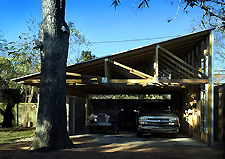
Letter From the Chair
The Small Project Practitioners Advisory Group is pleased to
present Journal No. 34, "Small Project Awards." The subject of this
eJournal is possibly the most important effort the Small Firm
Forum, now the Small Project Practitioners, has yet to offer. For
nearly two years, the advisory group has planned and programmed a
viable means to acknowledge the many outstanding contributions to
our communities and our profession in architecture design and
project delivery. The result of this effort is the Small Project
Awards, which we offer here.
In a national call, we received more than 80 submissions
representing a wide range of project types, styles, scale, and
construction value: residential, commercial, whimsical,
traditional, and cutting edge. A jury, made up of members of the
Committee on Design and led by moderator Charles Matta, FAIA, met
in Washington in February. After a full day of consideration, the
jury selected nine projects to receive the Small Project Award. At
a reception held during the AIA national convention in Las Vegas,
the projects and project architects were presented with their
awards.
It is with great pleasure that we share with you those winners in
this issue. Quality architecture, no matter the scope, duration, or
budget, has great value to our profession and to our community, and
needs to be recognized when appropriate and shared with our peers
and the public. We hope you will enjoy viewing the award winners
but, more important, we hope you will consider sharing your best
projects with us next year.

David C. Hughes, AIA
2005 Chair
2005 Small Project Awards
The Toolbox
Bruce Roadcap Architecture
Architect’s Comments
The “Toolbox” is a new covered parking, storage, and
workbench space replacing a 1920s single-car garage for a bungalow
 residence. The
program dictated squeezing parking for two cars between a massive
pecan tree and the back corner of the property. The existing slab
was re-used and the new slab additions minimized to prevent
damaging the large tree.
residence. The
program dictated squeezing parking for two cars between a massive
pecan tree and the back corner of the property. The existing slab
was re-used and the new slab additions minimized to prevent
damaging the large tree.
The project is open on all sides to reduce scale and provide
ventilation and natural light. The workbench is visually separated
from the structure and opens completely to the covered slab beyond
two pairs of rolling metal doors. The doors are suspended from a
laminated wood beam supported on poured-in-place concrete columns,
which provide lateral support for the open structure. Wood studs
and trusses are spaced 24 inches apart to maximize storage of tools
and equipment between and within the thickness of the walls. A
canvas panel is stretched over the last truss and pulled taught
within the web to express the structural form. Bolts, screws, and
all structural hardware are oversized and extended to accentuate
connections. The small view port in the workbench area is sized to
the wood siding and the stud spacing, providing a direct view to
the children's play area. The wood siding (no. 105) and color match
the original 1920 house, while the corrugated galvalume roofing and
louvers recall the former garage.
Jury Comments
- “A nicely scaled outdoor space for working and parking. The simple, clear details and skillful use of materials work well together. Every square inch of this little building was functional.”
- “The Toolbox was a clever project further strengthened by the sensitive use of ordinary materials. This was a favorite of the jury.”
- "This was a crisp and finely detailed project. We liked the clearly articulated elements and the successful integration of the various materials, particularly the canvas infill in the gable."
Small Project Awards Jury
Ronnette Riley, FAIA, Chair
Ronnette Riley Architects
New York
David Brems, AIA, Vice Chair
Gillies Stransky Brems Smith PC
Salt Lake City
Carol Bentel, FAIA
Bentel & Bentel Architects and Planners
Locust Valley, NY
Louis Pounders, FAIA
Williamson Pounders Architects
Memphis
![]()
![]()
Site Map | Privacy
| Help
©2005 The American Institute of Architects, All Rights
Reserved.